NBN Co is hoping to force apartment dwellers to take on owners corporations that continuously stand in the way of connecting their blocks to the National Broadband Network.

The company is formalising "protocols" to deal with property owners that "consciously" and "persistently" refuse NBN Co or its contractors access to connect the building to the fibre network.
It is also backing a proposed change to Telstra's Migration Plan that would put pressure on apartment residents to act sooner rather than later against resistive owners' corporations.
That change seeks to clarify Telstra's cease sale obligation, which prevents the carrier from supplying new copper or cable-based services in areas that have been declared "NBN serviceable".
Some NBN rollout areas that are declared serviceable may contain premises that aren't physically connected to the fibre network. These premises are termed "frustrated".
The source of frustration might be the owners corporation blocking access to NBN Co and its contractors as they try to run fibre from the street to the basement.
As it stands, the Migration Plan allows Telstra to continue selling new copper broadband services into "frustrated" buildings, right up to the time when the copper lines into the building are physically disconnected (as required by the definitive agreements). This could be 18 months or more after the area around the building becomes NBN serviceable.
Making "frustrated" premises subject to the cease sale clause would stop Telstra from selling new copper-based services to those premises 20 business days after the area is declared NBN serviceable.
In other words, any residents in the block that want a new fixed-line broadband service won't be able to get one on the building's existing copper lines. And, as the building lacks NBN cabling, they'll be faced with extremely limited options to get a new fixed-line connection.
NBN Co hopes that will be enough to get them to turn on the owners corporation and force the building onto the NBN well before the existing copper lines are disconnected.
"It will demonstrate the adverse consequences of preventing NBN Co from connecting a premise to the fibre network before the disconnection date," NBN Co said. (pdf)
"It will facilitate the migration of end-user customers, especially in MDUs [Multi-Dwelling Units], to the NBN fibre network, and it will potentially minimise the number of premises that are "frustrated" at the disconnection date".
From policy to protocol
Though NBN Co expects "frustrated" premises to crop up as a challenge in its fibre rollout, it is yet to have to classify a building as such.
One reason it suggests for this are exhaustive "internal policies and processes" that are already in place imploring NBN Co and its contractors to do everything possible to prevent "frustrated" premises in the rollout.
These processes are being formalised into "protocols" with assistance from the Department of Broadband, Communications and the Digital Economy. Work on the protocols is at an "advanced" stage, according to NBN Co.
Under the internal processes, and eventually the formal protocols, NBN Co's delivery partners must make three "good faith attempts" to resolve an issue with an owners corporation before escalating it to NBN Co with "appropriate evidence". NBN Co will make further attempts of its own before sending a "last chance letter" to every lot owner or resident, imploring them to act.
If that comes to nothing, the issue goes before a governance committee that has final say on premises classification.
The internal process already places some onus on apartment dwellers to intervene in a dispute between NBN Co and the owners corporation. The proposed Migration Plan change would put pressure on residents by limiting their internet service options on an ongoing basis.
In practice
NBN Co gives the example of an MDU of 20 premises, of which two are vacant when the area is declared NBN serviceable.
Under the existing Migration Plan, once those vacant units become occupied, the new residents could source copper-based internet services.
This would result in little if any pressure on the owner's corporation to connect to the NBN — at least until the whole building had its copper lines forcibly disconnected some 18 months later.
Under the amended Migration Plan, the new residents in the building wouldn't be able to get new internet services on the existing copper lines. They also wouldn't be able to get NBN fibre services, as the owner's corporation was refusing building access.
"Applying Telstra's Migration Plan varied as proposed to the above scenario would mean the new residents of the building will have stronger incentives to encourage the owners corporation to allow connection of the building to the NBN," NBN Co said.
"This is likely to encourage the owners corporation to apply to NBN Co to have the building connected to the NBN prior to the [copper] disconnection date.
"If connection of the building occurs before the disconnection date it is likely that some residents will migrate to the NBN, meaning that fewer residents will have their existing telephone and broadband services disconnected. Hence, fewer residents would experience service disruption".



_(20).jpg&h=140&w=231&c=1&s=0)
_(22).jpg&h=140&w=231&c=1&s=0)






 iTnews Executive Retreat - Security Leaders Edition
iTnews Executive Retreat - Security Leaders Edition












_(1).jpg&h=140&w=231&c=1&s=0)



